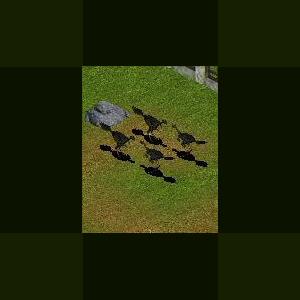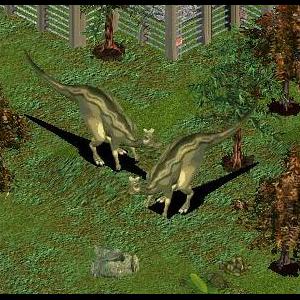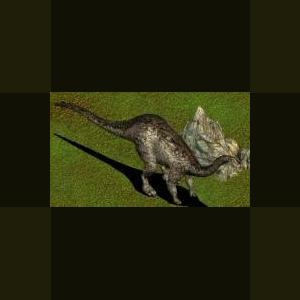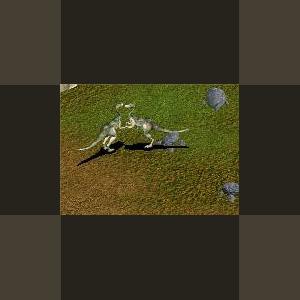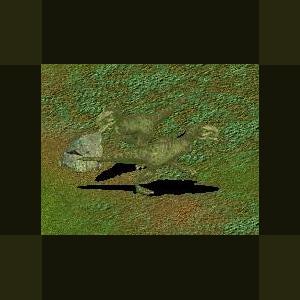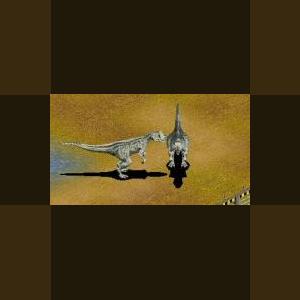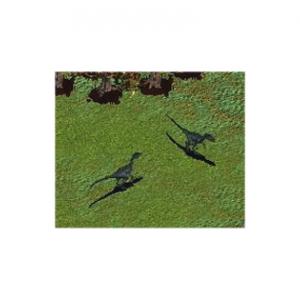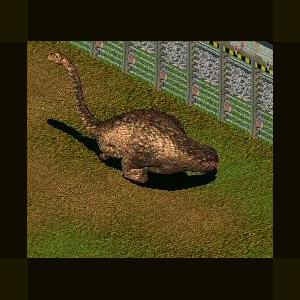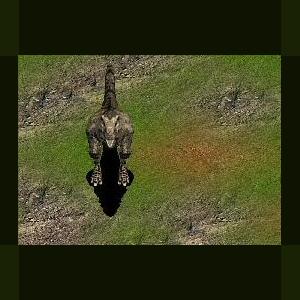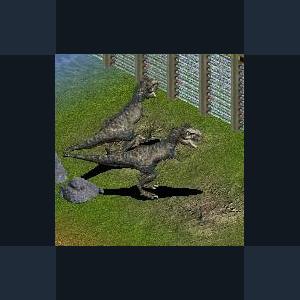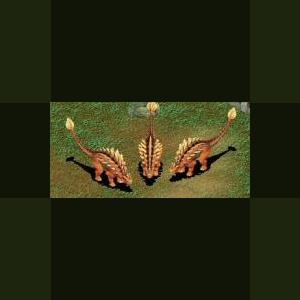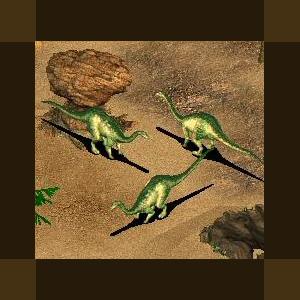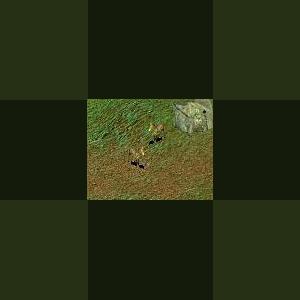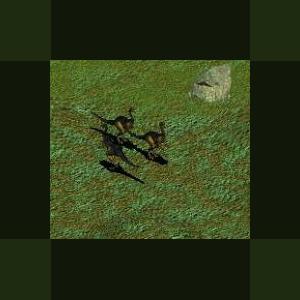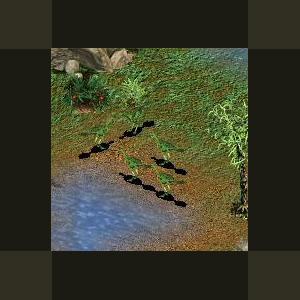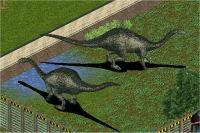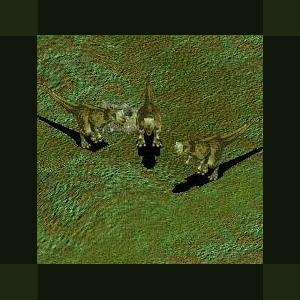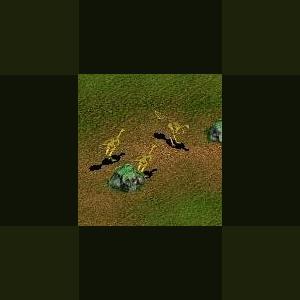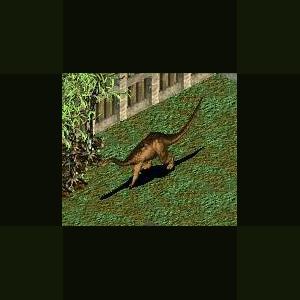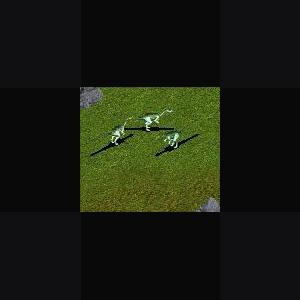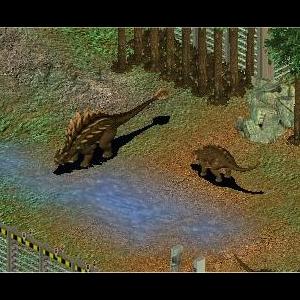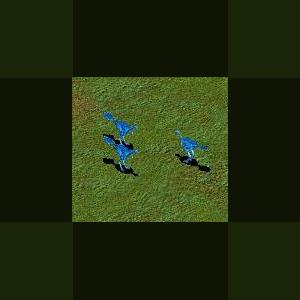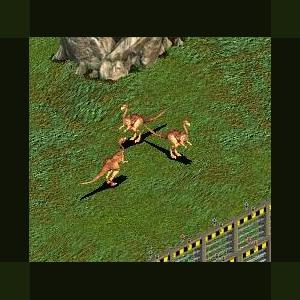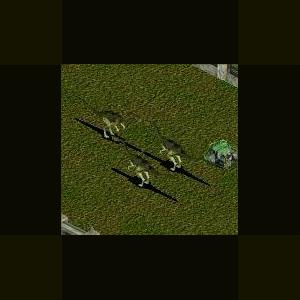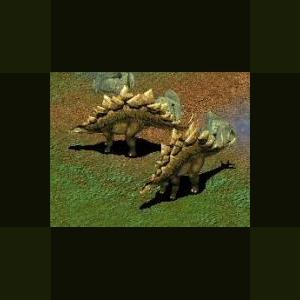Dinosaurs
Creatures from another age
241 files
-
Hagryphus by Moondawg
By Guest
Hagryphus
Hagryphus ("Ha's griffin", from Egyptian Ha, name of a god of the western desert and Greek gryphus meaning 'griffin' (a mythological bird-like creature); Zanno and Sampson, 2005) is an oviraptorosaurian theropod dinosaur from the Upper Cretaceous Period of what is now Utah.
To date, only a single species is known, H. giganteus. The holotype was discovered in the Kaiparowits Formation (Late Campanian) in the Grand Staircase-Escalante National Monument of southern Utah. Radiometric dating indicates that the beds where the specimen was found date to between 76 and 75 million years ago. Designated UMNH VP 12765, the type specimen resides in the collections of the Utah Museum of Natural History in Salt Lake City. It consists of an incomplete but articulated left manus and the distal portion of the left radius. Both the semilunate and radiale are preserved.
Other known species of North American oviraptorosaurs include Elmisaurus rarus, Microvenator celer, and Chirostenotes pergracilis. This group of dinosaurs is better known from the Cretaceous of Asia, where forms such as Khaan mckennai, Conchoraptor gracilis and Oviraptor philoceratops have been discovered.
Oviraptorosaurs are characterized by a shortened snout, massive endentulous jaws and extensively pneumatized skulls, often sporting elaborate crests, the function of which remains unknown. The toothless jaws may indicate a diet of eggs but these theropods likely fed on small vertebrates as well. Evidence suggests that they were feathered and some paleontologists consider them to be true birds (see the main article Oviraptorosauria for further information).
As the species name indicates, Hagryphus giganteus was a particularly large oviraptorosaur, estimated to have been approximately 3 meters (10 ft) long, which makes it one of the largest members of the clade Oviraptorosauria (Barsbold, 1976). H. giganteus is estimated to be 30-40% larger than the next largest known North American oviraptorosaur, Chirostenotes.
173 downloads
0 comments
Updated
-
Hypacrosaurus by Moondawg
By Guest
Hypacrosaurus
Hypacrosaurus (meaning "near the highest lizard", because it was almost but not quite as large as Tyrannosaurus) was a genus of duckbill dinosaur similar in appearance to Corythosaurus. Like Corythosaurus, it had a tall, hollow rounded crest, although not as large and straight. It is known from the remains of two species that lived about 76 to 68 million years ago, in the Late Cretaceous of Alberta, Canada, and Montana, USA, and is the latest hollow-crested duckbill known from good remains in North America. It was an obscure genus until the description of nests, eggs, and hatchlings belonging to H. stebingeri in the 1990s.
Hypacrosaurus is most easily distinguished from other hollow-crested duckbills (lambeosaurines) by its tall neural spines and the form of its crest. The neural spines, which project from the top of the vertebrae, are 5 to 7 times the height of the body of their respective vertebrae in the back, which would have given it a tall back in profile. The skull's hollow crest is like that of Corythosaurus, but is more pointed along its top, not as tall, wider side to side, and has a small bony point at the rear. Unlike other lambeosaurines, the passages for the airways do not form an S-curve in the crest (at least not in H. altispinus). The animal is estimated to have been around 9.1 meters long (30 feet), and to have weighed up to 4.0 tonnes (4.4 tons). As with most duckbills, its skeleton is otherwise not particularly remarkable, although some pelvic details are distinctive. Like other duckbills, it was a bipedal/quadrupedal herbivore. The two known species, H. altispinus and H. stebingeri, are not differentiated in the typical method, of unique characteristics, as H. stebingeri was described as transitional between the earlier Lambeosaurus and later Hypacrosaurus. Photographs of an adult H. stebingeri skull show an animal that looks very similar to H. altispinus.
Hypacrosaurus was a lambeosaurinae hadrosaurid, and has been recognized as such since the description of its skull. Within the Lambeosaurinae, it is closest to Lambeosaurus and Corythosaurus, with Jack Horner and Phil Currie (1994) suggesting that H. stebingeri is transitional between Lambeosaurus and H. altispinus, and Michael K. Brett-Surman (1989) suggesting that Hypacrosaurus and Corythosaurus are the same genus. These genera, particularly Corythosaurus and Hypacrosaurus, are regarded as the "helmeted" or "hooded" branch of the lambeosaurines, and the clade they form is sometimes informally designated Lambeosaurini. Although Suzuki et al.'s 2004 redescription of Nipponosaurus found a close relationship between Nipponosaurus and Hypacrosaurus stebingeri, indicating that Hypacrosaurus may be paraphyletic, this was rejected in a later, more comprehensive reanalysis of lambeosaurines, which found the two species of Hypacrosaurus to form a clade without Nipponosaurus, with Corythosaurus and Olorotitan being the closest relatives.
The type remains of Hypacrosaurus remains were collected in 1910 by Barnum Brown for the American Museum of Natural History. The remains, a partial postcranial skeleton consisting of several vertebrae and a partial pelvis (AMNH 5204), came from along the Red Deer River near Tolman Ferry, Alberta, Canada, from rocks of what is now known as the Horseshoe Canyon Formation (early Maastrichtian, Upper Cretaceous). Brown described these remains, in combination with other postcranial bones, in 1913 as a new genus that he considered to be like Saurolophus. No skull was known at this time, but two skulls were soon discovered and described.
During this period, the remains of small hollow-crested duckbills were described as their own genera and species. The first of these that figure into the history of Hypacrosaurus was Cheneosaurus tolmanensis, based on a skull and assorted limb bones, vertebrae, and pelvic bones from the Horseshoe Canyon Formation. Not long after, Richard Swann Lull and Nelda Wright identified an American Museum of Natural History skeleton (AMNH 5461) from the Two Medicine Formation of Montana as a specimen of Procheneosaurus. These and other taxa were accepted as valid genera until the 1970s, when Peter Dodson showed that it was more likely that the "cheneosaurs" were the juveniles of other established lambeosaurines. Although he was mostly concerned with the earlier, Dinosaur Park Formation genera Corythosaurus and Lambeosaurus, he suggested that Cheneosaurus would turn out to be composed of juvenile individuals of the contemporaneous Hypacrosaurus altispinus. This idea has become accepted, although not formally tested. The Two Medicine Procheneosaurus, meanwhile, was not quite like the other Procheneosaurus specimens studied by Dodson, and for good reason: it was much more like a species that would not be named until 1994, H. stebingeri.
H. altispinus shared the Horseshoe Canyon Formation with fellow hadrosaurids Edmontosaurus and Saurolophus, hypsilophodont Parksosaurus, ankylosaurid Euoplocephalus, nodosaurid Edmontonia, horned dinosaurs Montanoceratops, Anchiceratops, Arrhinoceratops, and Pachyrhinosaurus, pachycephalosaurid Stegoceras, ostrich-mimics Ornithomimus and Struthiomimus, a variety of poorly-known small theropods including troodontids and dromaeosaurids, and the tyrannosaurs Albertosaurus and Daspletosaurus. The dinosaurs from this formation are sometimes known as Edmontonian, after a land mammal age, and are distinct from those in the formations above and below. The Horseshoe Canyon Formation is interpreted as having a significant marine influence, due to an encroaching Western Interior Seaway, the shallow sea that covered the midsection of North America through much of the Cretaceous. H. altispinus may have preferred to stay more landward.
The slightly older Two Medicine Formation, home to H. stebingeri, was also populated by another well-known nesting hadrosaur, Maiasaura, as well as the troodontid Troodon, which is also known from nesting traces. The tyrannosaurid Daspletosaurus, caenagnathid Chirostenotes, dromaeosaurids Bambiraptor and Saurornitholestes, armored dinosaurs Edmontonia and Euoplocephalus, hypsilophodont Orodromeus, hadrosaur Prosaurolophus, and horned dinosaurs Achelousaurus, Brachyceratops, Einiosaurus, and Styracosaurus ovatus were also present. This formation was more distant from the Western Interior Seaway, higher and drier, with a more terrestrial influence.
As a hadrosaurid, Hypacrosaurus would have been a bipedal/quadrupedal herbivore, eating a variety of plants. Its skull permitted a grinding motion analogous to chewing, and its teeth were continually replacing and packed into dental batteries that contained hundreds of teeth, only a relative handful of which were in use at any time. Plant material would have been cropped by its broad beak, and held in the jaws by a cheek-like organ. Its feeding range would have extended from the ground to ~4 m (13 ft) above.
H. stebingeri laid roughly spherical eggs of 20 by 18.5 cm (7.9 by 7.3 inches), with embryos 60 cm long (23.6 in). Hatchlings were around 1.7 m long (5.6 ft). Young and embryonic individuals had deep skulls with only slight expansion in the bones that would one day form the crest. Growth was faster than that of an alligator and comparable to ratite growth, for several years, based on the amount of bone growth seen between lines of arrested growth (analogous to growth rings in trees). Research by Lisa Cooper and colleagues on H. stebingeri indicates that this animal may have reached reproductive maturity at the age of 2 to 3 years, and reached full size at about 10 to 12 years old. The circumference of the thigh bone at postulated reproductive maturity was about 40% that of its circumference at full size. The postulated growth rate of H. stebingeri outpaces those of tyrannosaurids (predators of hypacrosaurs) such as Albertosaurus and Tyrannosaurus; rapidly-growing hypacrosaurs would have had a better chance to reach a size large enough to be of defensive value, and beginning reproduction at an early age would also have been advantageous to a prey animal.
The hollow crest of Hypacrosaurus most likely had social functions, such as a visual signal allowing individuals to identify sex or species, and providing a resonating chamber for making noises. The crest and its associated nasal passages have also figured in the debate about dinosaur endothermy, specifically in discussions about nasal turbinates.
Turbinates are thin bones or cartilages that come in two types, with two functions. Nasal olfactory turbinates are found in all living tetrapods and function in smell. Respiratory turbinates function to prevent water loss through evaporation and are found only in birds and mammals, modern endotherms (warm-blooded animals) who could lose a great deal of water while breathing because they breathe more often than comparably-sized ectotherms (cold-blooded animals) to support their higher metabolism. Ruben and others in 1996 concluded that respiratory turbinates were probably not present in Nanotyrannus, Ornithomimus or Hypacrosaurus based on CT scanning, thus there was no evidence that those animals were warm-blooded.
204 downloads
0 comments
Updated
-
Camarasaurus by Moondawg
By Guest
Camarasaurus (KAM-ah-rah-SAWR-us) meaning 'chambered lizard', referring to the holes in its vertebrae was a genus of quadrupedal, herbivorous din
The arched skull of Camarasaurus may have contributed to the name 'chambered lizard'. The skull was remarkably square and the blunt snout had many fenestrae, though it was sturdy and is frequently recovered in good condition by paleontologists.
The 19 centimeter long (7.5 in) teeth were shaped like chisels (spatulate) and arranged evenly along the jaw. The strength of the teeth indicates that Camarasaurus probably ate coarser plant material than the slender-toothed diplodocids. Like a chicken, it may have swallowed stones (gastroliths) to help grind the food in the stomach and then regurgitated or passed them when they became too smooth.
Inspired by the Zoo Tek Brains Trust
267 downloads
0 comments
Updated
-
Harpymimus by Moondawg
By Guest
Harpymimus was a basal ornithomimosaur from the Early Cretaceous Period of what is now Mongolia. Unlike later, more derived ornithomimosaurs,
The holotype specimen (IGM 100/29, Mongolian Academy of Sciences, Ulan Bator, Mongolia) consists of an almost complete skeleton, lacking portions of the pectoral girdle, pelvic girles, and hindlimbs. It was recovered at Dundgovi Aimag (Eastern Gobi Province), from an exposure of the Shinekhudug Formation (Shinekhudukskaya Svita; Hauterivian to Barremian). The etymology of Harpymimus involves a reference to the fearsome Harpy of Greek mythology (Greek harpyiai = "Harpies" + Greek mimos = "mimic"). Only a single species is known for this genus, H. oklandnikovi. Other dinosaurs collected from the Shinekhudug Formation at Dundgov include the ceratopsian Psittacosaurus mongoliensis and the ornithopod Altirhinus kurzanovi.
Inspired by the Zoo Tek Brains Trust
134 downloads
0 comments
Updated
-
Eotyrannus by Moondawg
By Guest
Eotyrannus ("dawn tyrant") was a tyrannosauroid theropod dinosaur hailing from the Early Cretaceous Wessex Formation beds, included in Wealden Group, located in the southwest coast of the Isle of Wight, United Kingdom.
The remains, consisting of assorted skull, axial skeleton and apendicular skeleton elements, from a juvenile or subadult, found in a plant debris clay bed, was described by Hutt et al. in early 2001. The etymology of the generic name refers to the animal’s character as an "early tyrant", while the specific epithet is a mention to the discoverer of the fossil. Eotyrannus is a 6 meter-long theropod whose tyrannosauroid character is given by serrated premaxillary teeth with a D cross section, proportionally elongate tibiae and metatarsals. Primitive characters for Tyrannosauroidea are the elongate neck vertebrae and the long well developed arms forelimbs along with the undecorated dorsal surface of the skull, unlike the more advanced tyrannosaurids. However this animal, proportionally, has one of the longest hands in Theropoda known to date.
This theropod would be a probable predator of such herbivorous dinosaurs as Hypsilophodon and Iguanodon.
E. lengi’s find corroborates the notion that early tyrannosaurs were gracile with long forelimbs and three-fingered grasping hands, though the large size of the animal either means that early evolution for this clade was carried out at a large size or Eotyrannus developed large size independently.[2] The find of this animal in Europe puts interesting questions to the purported Asian origin for these animals along with North American Stokesosaurus and European Aviatyrannis arguing for a more complex biogeography for tyrannosaurs.
192 downloads
0 comments
Updated
-
Deltadromeus by Moondawg
By Guest
Deltadromeus ("delta runner") is a genus of theropod dinosaur from Northern Africa. This carnivore had long, unusually slender hind limbs for its size, suggesting that it was a swift runner.
It lived in the late Cretaceous Period, about 95 million years ago. It may have been one of the longest carnivorous dinosaurs, with one unpublished survey indicating that a referred partial specimen could represent an individual that was around 13.3 meters (44 ft) long, though it would have weighed only an estimated 3.5 tons, making it more slender than the giant carnosaurs. The more complete holotype specimen measured an estimated 8.1 m (26.5 ft) long. Deltadromeus skeletons have been found with those of the carnosaur Carcharodontosaurus, and it may have lived along side the even larger Spinosaurus. The specific name D. agilis, meaning "swift delta runner", comes from the fact that this species had adaptations for running, and that its remains were found in a fossilized river delta. Deltadromeus was originally described as a large coelurosaur, but more recent studies suggest it was actually a ceratosaur, possibly a gigantic member of the noasaurid family.
220 downloads
0 comments
Updated
-
Ebony Velociraptor by Ghirin
By Guest
Ebony Velociraptor
Author: Ghirin
http://www.zoo-tek.com/forums/index.php?download=109
The ebony velociraptor is a melanistic variant of the velociraptor. In melanism, the high production of melanin leads to dark brown or black fur and/or skin. Melanistic variants are found in many different species ranging from fish to mammals and in some cases this color variant does not pose a major handicap to the individual (unlike albinism and leucism).
Melanistic animals tend to have higher survival rates in areas of dense foliage, where the darker pigment might provide better camouflage. This appears to be the case in felines such as black leopards and jaguars. In other instances, such as animals living in open country with little plant cover would be at a disadvantage because they would be more conspicuous to prey or predators.
Like modern animals, melanistic individuals occurred in dinosaur populations. Predators that lived in forested areas probably had
References:
Designer Reptiles and Amphibians. R.D. Bartlett and Patricia Bartlett, 2001.
Reptile and Amphibian Variants: Colors, Patterns, and Scales. H. Bernard Bechtel, 1995.
The Corn Snake Manual. Bill Love and Kathy Love, 2000.
Walker's Mammals of World. Nowak, 1999.
Created by Ghirin
204 downloads
Updated
-
Barapasaurus by Moondawg
By Guest
Barapasaurus is curious because it is the earliest known sauropod, dating from the early Jurassic Period — more precisely the Toarcian age, about 189.6 to 176.5 million years ago. This is evident in the unspecialized nature of its form. Later sauropods like Brachiosaurus developed their own ecological niche and feeding strategies. However, Barapasaurus was something of an "all-purpose" dinosaur. For example, later sauropods developed hollow vertebrae, as a weight-saving measure. Barapasaurus vertebrae, on the other hand, were almost solid, with only the earliest hints of hollowing. (See also: Camarasaurus.)
Despite its early place in dinosaur history, Barapasaurus reached a length of about 18 metres (60 feet), and weighed about 48 tones (53 tons). Its height to the hip was approximately 5.5 metres (18 feet).
Like all sauropods, Barapasaurus was a herbivore. However, no skull has yet been recovered and so its exact diet has not been determined. A few lone teeth are known but not sufficient to make judgments on diet.
Barapasaurus is also important because, although its remains were found in India, it is very similar to other samples found in East Africa. From this we can conclude that during the early Jurassic period, these two land masses were still connected or at least only recently divorced.
Barapasaurus is included in Vulcanodontidae rather than Cetiosauridae, another family in Sauropoda. This classification is unconfirmed since insufficient work has been done on the skeletons. The description is justified by the narrow sacrum (a boxlike structure of the hip), which is a characteristic of vulcanodontids. However, the dorsal vertebrae display features shared with Cetiosauridae, such as a high neural arch above the vertebral foramen.
Currently the only known species is the original B. tagorsi.
The first bones of Barapasaurus were recovered in India in 1960. However, it was not until 1975 that this recovery was made the type specimen, and the official description published by Jain, Kutty, Roy-Chowdhury and Chatterjee of Calcutta.
Since then, five additional skeletons have been recovered from the Godavari Valley in southern India. However, none of these included the skull or feet. The remainder of the skeleton is known, so it is theoretically the best-known of the early Jurassic sauropods. Unfortunately, little work has yet been published regarding these discoveries.
296 downloads
0 comments
Updated
-
Daspletosaurus by Moondawg
By Guest
Daspletosaurus is closely related to the much larger and more recent Tyrannosaurus. Like most known tyrannosaurids, it was a multi-ton bipedal predator equipped with dozens of large, sharp teeth. Daspletosaurus had the small forelimbs typical of tyrannosaurids, although they were proportionately longer than in other genera.
As an apex predator, Daspletosaurus was at the top of the food chain, probably preying on large dinosaurs like the ceratopsid Centrosaurus and the hadrosaur Hypacrosaurus. In some areas, Daspletosaurus coexisted with another tyrannosaurid, Gorgosaurus, though there is some evidence of niche differentiation between the two. While Daspletosaurus fossils are rarer than other tyrannosaurids, the available specimens allow some analysis of the biology of these animals, including social behavior, diet and life history.
While very large by the standard of modern predators, Daspletosaurus was not the largest tyrannosaurid. Adults could reach a length of 8–9 meters (26–30 ft) from snout to tail. Mass estimates have centered around 2.5 tonnes (2.75 short tons)but have ranged between 1.8 tonnes (2 tons)and 3.8 tonnes (4.1 tons).
Life restoration of Daspletosaurus. Daspletosaurus had a massive skull that could reach more than 1 meter (3.3 ft) in length. The bones were heavily constructed and some, including the nasal bones on top of the snout, were fused for strength. Large fenestrae (openings) in the skull reduced its weight. An adult Daspletosaurus was armed with about six dozen teeth that were very long but oval in cross section rather than blade-like. Unlike its other teeth, those in the premaxilla at the end of the upper jaw had a D-shaped cross section, an example of heterodonty always seen in tyrannosaurids. Unique skull features included the rough outer surface of the maxilla (upper jaw bone) and the pronounced crests around the eyes on the lacrimal, postorbital, and jugal bones. The orbit (eye socket) was a tall oval, somewhere in between the circular shape seen in Gorgosaurus and the 'keyhole' shape of Tyrannosaurus.
Daspletosaurus shared the same body form as other tyrannosaurids, with a short, S-shaped neck supporting the massive skull. It walked on its two thick hindlimbs, which ended in four-toed feet, although the first digit (the hallux) did not contact the ground. In contrast, the forelimbs were extremely small and bore only two digits, although Daspletosaurus had the longest forelimbs in proportion to body size of any tyrannosaurid. A long, heavy tail served as a counterweight to the head and torso, with the center of gravity over the hips.
242 downloads
0 comments
Updated
-
Nanotyrannus by Moondawg
By Guest
Nanotyrannus ("tiny tyrant") is a genus of tyrannosaurid dinosaur, and is possibly a
juvenile specimen of Tyrannosaurus. Represented only by a small skull it was discovered by Charles W. Gilmore in 1942 and described in 1946 as a
specimen of Gorgosaurus lancensis (now known as Albertosaurus).In 1988, the
specimen was re-described by Robert T. Bakker, Phil Currie, and Michael Williams,
the late curator of paleontology at the Cleveland Museum of Natural History, where
the original specimen was housed and is currently on display. Initial research indicated
that the skull bones were fused, and that it therefore represented an adult specimen.
In light of this, Bakker and colleagues assigned the skull to a new genus, which they
named Nanotyrannus for its apparently small size.However, subsequent work has cast
doubt on this, and some paleontologists no longer consider it a valid genus--since the
fossil was a contemporary of Tyrannosaurus rex, many paleontologists now believe it to
be a juvenile T.rex, especially since the discovery in 2001 of new Nanotyrannus specimen,
nicknamed "Jane." The original Nanotyrannus specimen is estimated to have been around
17 feet (5.2 meters) long when it died.
In 2001, a more complete juvenile tyrannosaur ("Jane"),
belonging to the same species as the original Nanotyrannus specimen, was uncovered.
In 2005, a conference on tyrannosaurs focused on the issues of Nanotyrannus validity
brought about by the discovery of the Jane specimen, was held at the Burpee Museum of
Natural History. Several paleontologists, such as Phil Currie and Donald M. Henderson,
saw the discovery of Jane as a confirmation that Nanotyrannus was a juvenile T. rex or
closely related species.Peter Larson, on the other hand, continued to support a
separate genus for Nanotyrannus.The actual scientific study of Jane, set to be
published by Bakker, Larson, and Currie, may help determine whether Nanotyrannus is a
valid genus, whether it simply represents a juvenile T. rex, or whether it is a new
species of a previously identified genus of tyrannosaur.
Bakker has stated he believes Nanotyrannus hunted in packs. Teeth from multiple Nanotyrannus have been found in the bones of herbivorous dinosaurs.
In 2008, Nanotyrannus was featured in the second episode of Jurassic Fight Club, a pseudo-documentary about prehistoric predators.[8] The episode dismissed the ongoing scientific debate on the validity of the Nanotyrannus genus, with the producers preferring instead to present a speculative battle between two juvenile Tyrannosaurus and one Nanotyrannus (which was possibly a juvenile Tyrannosaurus). The episode depicted both genera as having pronated hands (hands with downward or backward-facing palms), something tyrannosaurids could not do.[9] The episode relied heavily on speculation to determine who would be the victor in the battle between the similar (or possibly synonymous) genera. Some television reviewers felt the battles depicted in the series were over-hyped and remarked negatively on the producers and experts' speculation about what the animals were thinking.[10]
191 downloads
Updated
-
Euoplocephalus by Moondawg
By Guest
It has been said that the herbivores and carnivores forced each other to evolve in a rapid escalating battle of armor vs. firepower.
If this is the case, and it seems very likely it is, then a very successful biological armored vehicle was Euoplocephalus.
Pronounced you-op-luh-SEF-uh-lus the name means "well protected head. This tank-like creature was from the late Cretaceous and is in the Ankylosaur family. It was believed to weigh in the 3 to 5 ton range and averaged 20 feet in length and maybe 8 or 9 feet in width.
What is unusual is that this heavily armored dinosaur was very likely totally immune to the attack of the large carnivores like T rex. It's strategy may well have been to first try and use it's bony and spiked tail to dissuade its attacker and then if that didn't work to simply hanker down in the sand or earth, protect its head and just out wait its adversary. As a side note there have been T rex leg bones found that were fractured in just the manner that Euoplocephalus would have done if it connected in a fight.
This species was the long end product of a very successful weeding out of less successful creatures. If it was for the Extinction Event that took out all of the dinosaurs this creatures descendants may well have been alive to this day. That is if the plants continued to survive. At this time (app. 70 MYA) we would have found cycads, tree ferns, bonze pines, katsura trees, and large conifers. but perhaps the defining tree would have been the bald cypress. These plants only thrived in humid and warm conditions and this is where these armored dinosaurs would have flourished.
Inspired by the Zoo Tek Brains Trust
231 downloads
0 comments
Updated
-
Kotasaurus by Moondawg
By Guest
Kotasaurus
Kotasaurus (pronounced KOHT-ah-SAWR-us) (meaning "Kota [Formation] lizard") is the name given to a genus of dinosaur from the Early Jurassic period, about 208 million to 188 million years ago. It was an early sauropod, sharing some similarities with prosauropods. Its fossils were found in 1988, in India, near a place called Yemanapalli, in the state of Andhra Pradesh.
It is the most primitive known sauropod, and is similar to prosauropods in some ways (the hip bones). This quadrupedal plant-eater was about 30 feet (9 m) long. It had a bulky body, a long tail and a long neck. It is known from a partial skeleton found in India (with no skull).
The type species, Kotasaurus yamanpalliensis, was described by P. Yadagiri in 1988.
The Geological Survey of India restored the skeletal remains of this giant skeleton and displayed at Birla Science Museum, Hyderabad.
Like all sauropods, Kotasaurus was an herbivore. However, no skull has yet been recovered and so its exact diet has not been determined. A few lone teeth are known but not sufficient to make judgments on diet.
195 downloads
0 comments
Updated
-
Merychippus by Moondawg
By Guest
Merychippus is a proto-horse that lived between 17 and 11 million years ago in the Miocene period.
It had three toes on each foot and is the first horse known to have grazed. Its name means "ruminant horse", but it is not now thought that Merychippus ruminated.
Merychippus lived in herds. It was about twelve hands (48 inches) tall; at the time it was the tallest equine to have existed. The muzzle was longer, the jaw deeper, and the eyes wider apart than any other horse-like animal to date. The brain was also much larger, making it smarter and more agile. Merychippus was the first equine to have the distinctive head of today's horses. The foot was fully supported by ligaments, and the middle toe developed into a hoof, which did not have a pad on the bottom. In some Merychippus species, the side toes were larger, whereas in others, they had become smaller and only touched the ground when running. Its teeth were like those of Parahippus (the extra crest that was variable in Miohippus was permanent in Merychippus, and the other teeth were beginning to form a series of tall crests with higher crowns).
195 downloads
0 comments
Updated
-
Dromiceiomimus by Moondawg
By Guest
Dromiceiomimus (meaning "Emu mimic") was a swift bipedal dinosaur from the late Cretaceous period, about 80 to 65 million years ago
It was about 12 feet (3.5 m) long and weighed about 220 to 330 pounds (100 to 150 kg). Its femur (thigh bone) was 468 mm long. This ornithomimid (a bird-like theropod) had very long limbs, hollow bones, and a large brain and eyes. It had a toothless, beaked mouth, and weak jaws.
The brains of ornithomimids were large for dinosaurs, but this may not necessarily be a sign of greater intelligence; some paleontologists think that the enlarged portions of the brain were dedicated to kinesthetic coordination. Compared to other ornithomimosaurs Drimiceiomimus had a short back, long slender forearms, very large eye sockets, and pelvic bones that were arranged somewhat differently.
The first fossil remains of this genus were discovered in the 1920s, and originally named Struthiomimus brevitertius and S. samueli. It was renamed by Russell in 1972 to D. brevitertius after an extensive review of North American ornithomimosaurs, which he reclassified into three genera: Dromiceiomimus, Ornithomimus, and Struthiomimus. Alberta, Canada's Horseshoe Canyon and Judith River Formations have yielded fossils of both adults and juveniles. The top speed of this dinosaur is believed to be 40 mph.
169 downloads
0 comments
Updated
-
Pedopenna by Moondawg
By Guest
Pedopenna
Pedopenna ("foot feather") was a small, feathered, maniraptoran dinosaur from the Daohugou Beds in China. It is possibly older than Archaeopteryx, though the age of the Daohugou Beds where it was found is debated. Some estimates give an Early Cretaceous age, but the latest radiometric dating shows them to be late Middle Jurassic (Callovian) (c.140-168 mya).
The name Pedopenna refers to the long pennaceous feathers on the metatarsus; daohugouensis refers to the locality of Daohugou, where the holotype was found. Pedopenna daohugouensis probably measured 1 meter (3 ft) or less in length, but since this species is only known from the hind legs, the actual length is difficult to estimate. Pedopenna is classified as a paravian (Paraves), the group of maniraptoran dinosaurs that includes Aves and their closest relatives.
The feet of Pedopenna resembled those of the related troodontids and dromaeosaurids (which together form the group Deinonychosauria), though were overall more primitive. In particular, the second toe of Pedopenna was not as specialized as in deinonychosaurs. While Pedopenna did have an enlarged claw and slightly shortened second toe, it was not as highly developed as the strongly curved, sickle-like claws of its relatives.
Xu and Zhang, who interpreted the Daohugou fossil beds where Pedopenna was found as mid to late Jurassic in age, used the presence of such a primitive member of the avian lineage, in combination with many primitive members of closely related lineages there, to support the idea that birds originated in Asia.
The avian affinities of Pedopenna are further evidence of the dinosaur-bird evolutionary relationship. Apart from having a very bird-like skeletal structure in its legs, Pedopenna was remarkable due to the presence of long pennaceous feathers on the metatarsus (foot). Some deinonychosaurs are also known to have these 'hind wings', but those of Pedopenna differ from those of animals like Microraptor. Pedopenna hind wings were smaller and more rounded in shape. The longest feathers were slightly shorter than the metatarsus, at about 55 mm (2 in) long. Additionally, the feathers of Pedopenna were symmetrical, unlike the asymmetrical feathers of some deinonychosaurs and birds. Since asymmetrical feathers are typical of animals adapted to flying, it is likely that Pedopenna represents an early stage in the development of these structures. While many of the feather impressions in the fossil are weak, it is clear that each possessed a rachis and barbs, and while the exact number of foot feathers is uncertain, they are more numerous than in the hind-wings of Microraptor. Pedopenna also shows evidence of shorter feathers overlying the long foot feathers, evidence for the presence of coverts as seen in modern birds. Since the feathers show fewer aerodynamic adaptations than the similar hind wings of Microraptor, and appear to be less stiff, suggests that if they did have some kind of aerodynamic function, it was much weaker than in deinonychosaurs and birds. Xu and Zhang, in their 2005 description of Pedopenna, suggested that the feathers could be ornamental, or even vestigial. It is possible that a hind wing was present in the ancestors of deinonychosaurs and birds, and later lost in the bird lineage, with Pedopenna representing an intermediate stage where the hind wings are being reduced from a functional gliding apparatus to a display or insulatory function.
133 downloads
0 comments
Updated
-
Cetiosaurus by Ghirin
By Guest
This therapod had a pair of bony ridges above its eyes and a horn on its snout. These were probably used by males when fighting for a mate.
Ceratosaurus (cera-TO-saur-US ) meaning 'horned lizard', in reference to the horn on its nose (Greek keras/keratos meaning 'horn' and sauros meaning 'lizard'), was a large predatory dinosaur from the Late Jurassic Period, found in the Morrison Formation of North America, in Tanzania and Portugal. It was characterized by large jaws with blade-like teeth, a large, blade-like horn on the snout and a pair hornlets over the eyes. The forelimbs were powerfully built but very short. The bones of the sacrum were fused (synsacrum) and the pelvic bones were fused together and to this structure (Sereno 1997) (i.e. similar to modern birds). A row of small osteoderms was present down the middle of the back.
187 downloads
0 comments
Updated
-
Fukuiraptor by Moondawg
By Guest
now Japan.
Scientists first thought it was a member of the Dromaeosauridae, but after studying the fossils they now believe it was related to Allosaurus. The type specimen is the skeleton of an individual about 4.2 metres long. It is thought that this specimen was not mature and an adult may have been larger. However, the other individuals recovered from the same locality are all juveniles that were smaller than the holotype (Currie & Azuma, 2006), in the smallest case less than a quarter of the holotype's size.
This specimen caused some confusion upon its initial discovery because its hand claw was mistaken for the killer claw on the foot of a dromaeosaur. It is now considered to be a basal member of the allosaur clade, and possibly similar or identical to the Australian "Allosaurus" species.
170 downloads
0 comments
Updated
-
Citipati by Moondawg
By Guest
Citipati (Sanskrit for 'funeral pyre lord') is a genus of oviraptorid theropod dinosaur from the Late Cretaceous Period of what is now Mongolia.
It is one of the best-known oviraptorids, thanks to a number of well-preserved skeletons, including several specimens found in brooding positions atop nests of eggs. These nesting specimens have helped to solidify the link between non-avian dinosaurs and birds.
The type species, Citipati osmolskae, was described by James M. Clark, Mark Norell, and Rinchen Barsbold in 2001. A second, as yet unnamed species may also exist. Citipati is often confused with the similar Oviraptor.
The largest Citipati were emu-sized animals and, at about 3 meters (9 ft) long, were the largest oviraptorids until Gigantoraptor was described in 2007. Like other oviraptorids, Citipati had an unusually long neck and shortened tail, compared to most other theropods. Its skull was unusually short and highly pneumatized (riddled with openings in the bone structure), ending in a stout, toothless beak. Perhaps the most distinctive feature of Citipati was its tall crest, superficially similar to that of a modern cassowary. The crest was relatively low in the type species, C. osmolskae, and taller, with a pointed tip, in a referred specimen which has not yet been assigned a specific name (provisionally labelled C. sp.).
173 downloads
0 comments
Updated
-
Efraasia by Ghirin
By Guest
Efraasia (named in honor of Eberhard Fraas) was a prosauropod discovered in Triassic deposits from Germany.
*Inspired by the Zoo Tycoon Brains Trust at the Zoo Tek Forums*
173 downloads
0 comments
Updated
-
Podokesaurus by Moondawg
By Guest
The only fossils of Podokesaurus holyokensis (the full name given by Talbot) were recovered in 1911 by Mount Holyoke College professor of geology and geography, Mignon Talbot from a boulder near to the college. It was formally described that year based on a poorly preserved, incomplete fossil skeleton.
This fossil evidence suggests that it may not be a distinct genus but in fact a species of Coelophysis, standing 1 m (3 ft) long and 0.3 m (1 ft) high, and weighing 4 kg (10 lb). The matter is complicated because all the original fossil evidence for Podokesaurus holyokensis was destroyed in a fire and only casts remain in The Division of Paleontology at the American Museum of Natural History, New York.
115 downloads
0 comments
Updated
-
Euplocephalus by Ghirin
By Guest
Euplocephalus ("Well Armored Head") was a large ankylosaur from the Cretaceous period of North America.
It is one of the best known genera of this dinosaur group, with 40 known specimens.
Reference:
The Illustrated Encylopedia of Dinosaurs by Dougal Dixon. 2006
www.wikipedia.com
*Inspired by the Zoo Tycoon Brains Trust at the Zoo Tek Evolved Forums
225 downloads
0 comments
Updated
-
Rinchenia by Moondawg
By Guest
Rinchenia
Rinchenia was a genus of Mongolian oviraptorid dinosaur from the Late Cretaceous Period. Rinchenia mongoliensis was originally considered a species within the genus Oviraptor (named Oviraptor mongoliensis by Rinchen Barsbold in 1986), but a re-examination by Barsbold in 1997 found differences significant enough to warrant a separate genus. The name Rinchenia was coined for this new genus by Barsbold in 1997, though he did not describe it in detail, and the name remained a nomen nudum until used by Osmólska et al. in 2004.
Rinchenia is known from a single specimen (GI 100/32A) consisting of a complete skull and lower jaw, partial vertebral column, partial forelimbs and shoulder girdle, partial hind limbs and pelvis, and a furcula ("wishbone"). While Rinchenia was about the same size as Oviraptor (about 1.5 meters, or 5 ft long), several features of its skeleton, especially in the skull, show it to be distinct. It skeleton was more lightly built and less robust than that of Oviraptor, and while the crest of Oviraptor is indistinct because of poor fossil preservation, Rinchenia had a well-preserved, highly developed, dome-like casque which incorporated many bones in the skull that are free of the crest in Oviraptor.
183 downloads
0 comments
Updated
-
Hypsilophodon by Moondawg
By Guest
Hypsilophodon
Hypsilophodon ( meaning 'high-crested tooth') is an ornithopod dinosaur genus from the Early Cretaceous Period of Europe. It was a small bipedal animal with an herbivorous or possibly omnivorous diet. Abundant fossil remains found in England indicate that Hypsilophodon reached about 2 meters (6.5 feet) in length.
The first remains of Hypsilophodon were recovered in the early days of paleontology in 1849. However, at the time, the bones were thought to belong to a young Iguanodon. It was not until 1870 that paleontologist T. H. Huxley was able to publish a full description of Hypsilophodon as we know it today. He had been provided with a number of skeletons by the Reverend William Fox, after whom the first species of Hypsilophodon was named.
Early paleontologists modeled the body of this small, bipedal, herbivorous dinosaur in various ways. In 1882 some paleontologists suggested that, like a modern tree-kangaroo, Hypsilophodon was able to climb trees in order to seek shelter. This was the accepted view for almost a century. However, Peter M. Galton finally performed more accurate analysis of the musculo-skeletal structure in 1974 and convinced most paleontologists that Hypsilophodon remained firmly on the ground.
Since then, three near-complete and over twenty minor finds have been made, especially on the Isle of Wight, off the south coast of England. Other finds have been made in southern England and Portugal.
Another misconception concerning the anatomy of Hypsilophodon was that it was armoured. The putative armour, consisting of thin mineralized plates from the torso, instead appear to be examples of intercostal plates associated with the rib cage. Such plates are better known from Talenkauen and Thescelosaurus, and were probably cartilaginous in origin.
There is only one known species of Hypsilophodon, Huxley's original H. foxii. Galton and Jensen named another species in 1979, H. wielandi, which is based on a thigh bone from South Dakota, USA, but it is now regarded as an indeterminate basal ornithopod.
Hypsilophodon was a relatively small dinosaur. While not quite so small as, for example, Compsognathus, Hypsilophodon was only around 2.3 metres in length. It would have reached approximately waist-height on a modern man and would have weighed about the same, at 50 to 70 kilograms (110 to 150 lb).
Like most small dinosaurs, Hypsilophodon was bipedal and ran on two legs. Its entire body was built for running; a light-weight, minimized skeleton, low, aerodynamic posture, long legs and stiff tail for balance all would have allowed it to travel remarkably fast for its size.
Due to its small size, Hypsilophodon fed on low-growing vegetation, most likely preferring young shoots and roots in the manner of modern deer. The structure of its skull, with the teeth set far back into the jaw, strongly suggests that it had cheeks, an advanced feature that would have facilitated the chewing of food. There were twenty-eight to thirty ridged teeth in the animal's jaw which, due to their alternate arrangement, appear to have been self-sharpening. As in almost all dinosaurs and certainly all the ornithischians, the teeth were continuously replaced.
The level of parental care in this dinosaur has not been defined, although a neatly-arranged nest has been found, suggesting that some care was taken before hatching. Fossils of large groups have been found, so it is likely that the animals moved in herds. For these reasons, the hypsilophodonts, particularly Hypsilophodon, have often been referred to as the "deer of the Mesozoic".
Despite living in the last of the periods in which dinosaurs walked the earth, the Cretaceous, Hypsilophodon had a number of primitive features. For example, there were five digits on each 'hand' and four on each foot. Most dinosaurs had lost these redundant features by the Cretaceous period. Also, although it had a beak like most ornithischians, Hypsilophodon still had pointed triangular teeth in the front of the jaw. Most herbivorous dinosaurs had, by this stage, become sufficiently specialized that the front teeth had been altogether lost (although there is some debate as to whether these teeth may have had a specialized function in Hypsilophodon).
The group Hypsilophodontidae remained remarkably static from the late Jurassic to the end of the Cretaceous. It is possible that this was because the animals were almost perfectly adapted to their lifestyle, therefore selective pressure, it is assumed, was low.
http://en.wikipedia.org/wiki/Hypsilophodon
191 downloads
0 comments
Updated
-
Byronosaurus by Moondawg
By Guest
Byronosaurus
Byronosaurus was a troodontid dinosaur which lived during the Late Cretaceous Period. It was named for Byron Jaffe, "in recognition of his family's support for the Mongolian Academy of Sciences-American Museum of Natural History Paleontological Expeditions." The first example of Byronosaurus was discovered in 1993 at Ukhaa Tolgod, Gobi Desert, Mongolia; a second was found in 1996 at Bolor's Hill, about 8 kilometers away (5 miles).
Byronosaurus was a small, agile dinosaur that was probably only 1.5 meters long (5 ft) and 50 centimeters high (17 in). It weighed only about 4 kilograms (9 lbs). Unlike most other troodontids, its teeth seem to lack serrations. They are instead needle-like, probably best suited for catching small birds, lizards and mammals. Specifically, they resemble those of Archaeopteryx, the bird-like dinosaur.
The remains of two individuals have been found, including two skulls. One, measuring 23 centimeters long (8 inches), is better preserved than any other troödontid skull found to date. It has a chamber in the snout where air enters from the nostrils before passing through to the mouth - another feature similar to that found in birds.
170 downloads
0 comments
Updated
-
Wuerhosaurus by Moondawg
By Guest
Wuerhosaurus was a Chinese stegosaur from Early Cretaceous period. It was roughly 7 metres long.
Wuerhosaurus homheni is the type species, described by Dong Zhiming in 1973 from the Tugulu Group in Xinjiang, western China. A smaller species from the Ejinhoro Formation in the Ordos Basin in Inner Mongolia, W. ordosensis, was formalized by the same researcher in 1993.
It was lower to the ground than most other stegosaurids; scientists believe that this was an adaptation to let it feed on low-growing vegetation. Unlike Stegosaurus, Wuerhosaurus had shorter, rounded plates, whose purpose is debated. Wuerhosaurus, like other stegosaurids, had a thagomizer on the end of its tail, which featured four bony spikes that would most likely have been used for self-defense.
Inspired by the Zoo Tek Brains Trust
219 downloads
0 comments
Updated

